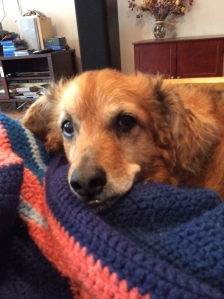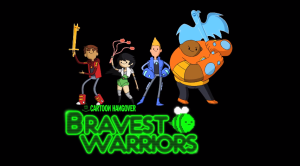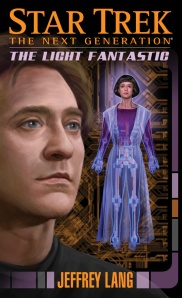So, as I was saying, Albert Lee died.
Looking back at those last couple months, it’s difficult to understand how we slogged through each day. Any of you who has ever had to deal with the decline of a member of your family (two-legged or four-) knows what I mean. You just push ahead, every day watching the ailing one, hoping that you’re clear-headed enough to make good decisions on their behalf, thinking about their needs while not being completely oblivious to your own. I’ve been lucky in that regard up until now — not having to ponder these matters too often and not (so far) with humans — but I suppose the day will come (unless I pull a fast one and go first).
But enough of such grim thoughts: Albert died. We did the best we could for him and I think we did okay. After he died, we had him cremated and they gave us a nice little wooden box filled with ashes that, as Graham Chapman once said, we can pretend are his. The box sits on the mantle with his collar and his favorite food bowl surrounded by an honor guard of metal bunny statues that I bought at a knick-knackery in Ardmore. If one of the cats wants to try to pee on him, he’s going to have to work really hard to do it.
One of the questions you hear a lot after your animal dies is “Are you going to get another one?” The world, I’ve discovered, is divided between people like my father, who cannot conceive of ever having a relationship like the one he had with a deceased animal (his dog, Heidi) and so, therefore, will not consider the prospect, and people like Helen and me.
Yes, of course we’ll get another dog. We like dogs. We like having them around. While we both are people who like structure and organization, we’re also people with fewer ties to Planet Earth than some. We both work at home; our family ties are relatively modest; and we’re not the sort that has large, varied groups of friends. Neither of us is a hermit, but on the Introvert-Extrovert scale, we’re both definitely somewhere closer to the “I” end of the scale. Having creatures around — pets, companion animals, whatever you want to call them — grounds us both and gives us something to think about other than our self-absorbed selves. When a cat thinks it’s time for something to eat, he will sit on your keyboard. When a dog thinks it’s time to go out for walkies, the sound of their toenails clicking as they circle the room is the only sound you can hear. The animals we live with ground us, which is a fine thing because, otherwise, I think we might just both float away like the balloons I always swore I would hang onto at the county fair and never, ever did. How many balloons have I watched turn into tiny dots on the horizon? Answer: Lots.
So, yes, we got another dog. Two, in fact: Joey and Lia. Helen found Joey on a adoption web-site and contacted the owner of the rescue, a nice woman named Pat. After reading through our applications and checking our references, Pat invited us to her farm in central PA to meet Joey, who was one of the 20-something animals she was caring for, mostly boarder collies and shelties. Joey and Lia are brother and sister, both sheltie-keeshond mixes, and had been brought to Pat when their previous owner couldn’t care for them anymore. We don’t know many details about their lives before Pat took them in, except that they spent a lot of time in crates, which they now loathe and will not enter. Lia had been adopted a little while before we found Joey and, even on the first day we met her, Pat was having misgivings about the decision to separate them.
Joey was very sweet when we first met him and, for want of a better word, soft-spoken, with a gentle spirit that occasionally boarders on timidity. He was flinch, like he was accustomed to being if not physically abused, then verbally intimidated. We liked him right away and decided to bring him home and see how he fit in.
The first couple weeks did not go well. While two of our cats — Kirby and Tumble — were more-or-less fine with having a dog in the house again, Puffy (the King of Everything) was incensed and needed to let everyone everywhere know of his displeasure as frequently as possible. Clearly, this made Joey feel anxious. He did not eat as much as he might have and, for want of a better word, he sulked. All the time.
We took Joey to our vet, the redoubtable Dr. Peters, who pronounced him healthy except for a mild case of colitis, caused, he said, by anxiety. Dr. Peters also was kind enough to tell Joey, in a low murmur (his signature move), that Joey was “the winner of the dog lottery,” which is a nice thing to hear, except for when your new four-legged companion seems miserable all the time.
We called Pat, who quickly made her diagnosis: “He misses his sister.” I confess I had my doubts. Why hadn’t Joey seemed sulky to Pat after Lia had been adopted? Helen’s (reasonable) response: “That would be difficult to pick up when you’re surrounded by 20 dogs.” Fine. This seemed like a sensible reply. But what, if anything, could be done? Joey was with us; his sister was with her new family. Should we send him back to Pat where he seemed at least moderately happier, surrounded by a pack?
Helen and Pat conferred. They plotted. They planned. I remember distinctly one afternoon sitting in my office with Joey sitting on the couch and we heard the two ladies talking on the phone in a far room. We looked at each other and Joey cocked his head at me in a distinctive doggy “WTF is going on?” way. I shrugged (my go-to move). It’s best not to ask when such Powers are unfolding.
So, Pat talked to Lia’s owner. Lia, it turned out, was not quite the kind of dog they had been hoping for. She was not a lap dog. She did not lick faces. She was pouty. Would they bring her back? Of course they would, especially if they could get a non-pouty, licky, lap-sitty dog in exchange. (They did, by the way, and everyone seems happy).
I’d like to report that there was an astonishing puppy-tastic reunion scene when Joey and Lia were reunited, but I would be lying. They aren’t human and who knows what passes between them in smell and taste, which is a dog’s primary way of experiencing the world. If their expressions betrayed anything close to a human emotion, I would say it was approximately exasperation. It was the look of a sibling who had given another sibling a ride to the mall to “pick up just one thing” and then disappeared for hours. There was some licking a bit of tail-wagging and then everything resumed its normal course in their lives.
Right now, at this moment, they are out back in the yard, desperately convinced that every squirrel who lives in our neighborhood should, y’know, come on down and say, “Hi!” We won’t hurt you, the dogs say with their swinging tails, but their anxious expressions betray their intentions. They are together almost every moment of the day, except for a couple hours in the evenings when Lia likes to crash out on the couch with Helen, while Joey prefers to sleep under her desk in her office.
Here they are now, trying to look prim and proper:
BTW, Lia is shorn, but will eventually become as fluffy as Joey.
Yes, after six years of having my dog, I am now the second, the Other Guy, the one who is Along For Walks. It’s actually kind of nice to not be the object of such intense affection. They’re Helen’s dogs and she must learn to be comfortable being the center of the universe. I’m cool with that.
WHAT ELSE IS GOING ON?
Eh. This and that. I’m waiting for the nice folks at Pocket to send approval for an outline and a contract so I can get to work on my next novel. I’m confident it will happen, though I’d hoped it would have happened, y’know, sooner. On the plus side, the delay has given me time to finish reading “The Fall,” which I may just do a short post on later this month. Overall, I think it’s a tremendously ambitious work, with some stand-out moments. As opposed to some posts I’ve read here and there, I love the political bent of the Trek universe these days. Also, I love the fact that some of my fellow Trek authors took some big swings in this series and connected solidly. Frankly, I’ve never like Deanna Troi as much as I’ve liked her when James Swallow writes her and Una McCormack’s Garak is a joy.
Also, I’ve had a chat with an agent about Kirby, which I hope will lead to another chat and then another. If nothing else, our conversation made me sit down and do a formal analysis of the plot and made me see places where (he said grudgingly) there are plot problems. I see a rewrite in the future; the question is how extensive it needs to be, but I think I’ll let the answer to that question unfold from the outcome of my chats.
Last, I’m seriously considering going to Philcon next month. Anyone else? I’ve never been to this venerable show, despite having lived in this part of the state for over 25 years. Opinions?
And that’s that for now. Can I be more faithful and report back a bit more frequently? Let’s face it — probably not. But I’ll try.
Cheers,
JL


















